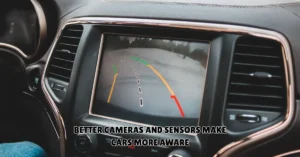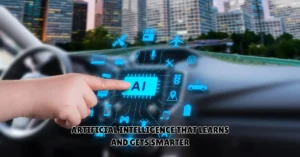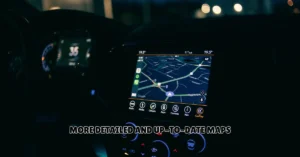
5 Major Steps Forward in Self-Driving Cars: What You Need to Know
- 55
- 0
- 0
Advancements in autonomous vehicles are changing the way we think about transportation. These vehicles, also known as self-driving cars, use technology like sensors, cameras, and artificial intelligence (AI) to navigate roads without the need for human drivers. The goal is to create safer, more efficient transportation by reducing accidents and human error. Autonomous vehicles can follow traffic rules, avoid obstacles, and even make decisions in real time, making them a promising solution for the future of mobility. While still in development, these cars have the potential to transform various industries, from public transportation to delivery services.
However, challenges such as safety concerns, regulatory approval, and technological improvements still need to be addressed. As advancements continue, self-driving cars could soon be a regular part of everyday life.
5 Major Steps Forward in Self-Driving Cars: What You Need to Know
Self-driving cars have made incredible progress in recent years. As car companies and tech firms work hard to make autonomous vehicles safer and better, we want to share the most important developments that are changing how these vehicles work. Here are five key areas where self-driving technology has taken big steps forward.
Better Cameras and Sensors Make Cars More Aware

One of the biggest improvements in self-driving cars is how they can now “see” the world around them much more clearly. The latest sensors and cameras work better in all types of weather and can spot things farther away than ever before.
Today’s autonomous vehicles use several types of sensors working together:
- New high-definition cameras can spot road signs, traffic lights, and other cars from hundreds of feet away.
- LIDAR (Light Detection and Ranging) sensors create detailed 3D maps of the surroundings by bouncing laser beams off objects
- Radar systems help cars “see” through fog, rain, and snow.
- Ultrasonic sensors help with precise parking and movement at low speeds.
These improved sensors mean self-driving cars can now notice and react to their surroundings almost instantly. They can tell the difference between a paper bag blowing across the road (which they can drive through) and a solid object they need to avoid. This makes them much safer and more reliable in real-world conditions.
Artificial Intelligence That Learns and Gets Smarter

The computers that control self-driving cars now use advanced artificial intelligence (AI) that can learn from experience, just like human drivers do. This AI gets better at handling unusual situations the more it drives.
Modern autonomous vehicles can now:
- Remember and learn from millions of miles of driving data
- Predict what other drivers, cyclists, and pedestrians might do next
- Make split-second decisions based on complex road situations
- Handle unexpected events like construction zones or accidents
This learning ability is crucial because it’s impossible to program a car for every situation it might face. Instead, the AI learns general rules about safe driving that it can apply to new situations, much like how human drivers use their judgment and experience.
Cars That Talk to Each Other and Road Infrastructure

A breakthrough in autonomous vehicle technology is how cars can now communicate with each other and with smart road systems. This is called Vehicle-to-Everything (V2X) communication, and it’s making self-driving cars much safer.
Here’s what this means in practice:
- Cars can warn each other about accidents or road hazards ahead
- Traffic lights can tell approaching cars when they’re about to change
- Road sensors can alert cars about ice, wet conditions, or other dangers
- Parking structures can guide cars to empty spots automatically
This connection between cars and infrastructure helps prevent accidents before they happen. It’s like having an entire network of helpers watching out for each car and sharing important information instantly.
More Detailed and Up-to-date Maps

Self-driving cars now use much more detailed maps than the ones we use for navigation. These HD maps include information about:
- The exact position of lane markers, curbs, and road edges
- The height of bridges and overpasses
- The location of traffic signs and signals
- Speed limits and road rules for every street
- Temporary changes due to construction or events
These maps are updated constantly as cars drive around and notice changes. When one self-driving car learns about a new road condition or construction zone, it can share this information with all other vehicles using the same system.
This detailed mapping helps cars plan their routes better and know exactly where they are on the road, down to a few inches. It’s like having a super-detailed blueprint of every road the car might drive on.
Better Testing and Safety Systems

Companies developing self-driving cars have greatly improved how they test and verify their vehicles’ safety. This includes:
New Testing Methods:
- Advanced computer simulations that test millions of driving scenarios
- Controlled testing areas that recreate real-world driving conditions
- Regular road tests with safety drivers ready to take control
- Special testing for harsh weather conditions
Backup Safety Systems:
- Multiple computers that check each other’s decisions
- Backup power systems and controls
- Systems that can safely pull over if something goes wrong
- Regular software updates to fix any problems that are found
These improved testing methods help make sure self-driving cars are ready for real-world use. Companies now test their vehicles in many more situations than they did just a few years ago, which helps find and fix problems before cars go on public roads.
What This Means for the Future
These five areas of progress show that self-driving cars are becoming more capable and reliable. While fully autonomous vehicles that can drive anywhere aren’t here yet, each of these improvements brings us closer to that goal.
The technology is still developing, and companies continue to work on making self-driving cars even better. As these systems improve, we’ll likely see more autonomous vehicles on the roads, starting with specific uses like delivery vehicles and taxi services in well-mapped areas.
For now, even cars with some self-driving features still need human drivers to pay attention and be ready to take control. But these advances show that autonomous vehicles are becoming more capable every year, and they’re getting closer to being a common sight on our roads.
Remember that self-driving technology keeps changing quickly, and new improvements happen all the time. These five areas are just the main highlights of recent progress, but companies are working on many other ways to make autonomous vehicles better and safer.
FAQs
What are autonomous vehicles?
Autonomous vehicles, or self-driving cars, use sensors, cameras, and AI to drive without human control. They can detect obstacles, follow traffic rules, and navigate roads safely, reducing accidents and making transportation more efficient.
How do autonomous vehicles work?
These vehicles use advanced technology like AI, GPS, sensors, and cameras to understand their surroundings. They process real-time data to make driving decisions, such as stopping at signals, avoiding obstacles, and maintaining safe distances.
What are the benefits of autonomous vehicles?
Self-driving cars can reduce traffic accidents, lower transportation costs, and improve mobility for people with disabilities. They also help reduce traffic congestion and fuel consumption by driving efficiently and following optimal routes.
What challenges do autonomous vehicles face?
Challenges include safety concerns, high costs, and adapting to different road conditions. Autonomous cars also need better laws, improved technology, and public trust before they can be widely used in everyday transportation.
When will autonomous vehicles be common?
Experts predict autonomous cars will become more common in the next 10–20 years. Many companies are testing them, but improvements in technology, safety, and regulations are needed before they become widely available.
Also Read:
5 Electric Cars of 2025: Innovations and Trends in India
References:
https://en.wikipedia.org/wiki/Self-driving_car
https://en.wikipedia.org/wiki/History_of_self-driving_cars
https://www.researchgate.net/publication/352702310_Self_Driving_Cars_All_You_Need_to_Know
Disclaimer:
The information provided in this blog about advancements in autonomous vehicles is for general informational purposes only. It does not constitute professional advice. The technology is still evolving, and actual results may vary depending on various factors.

